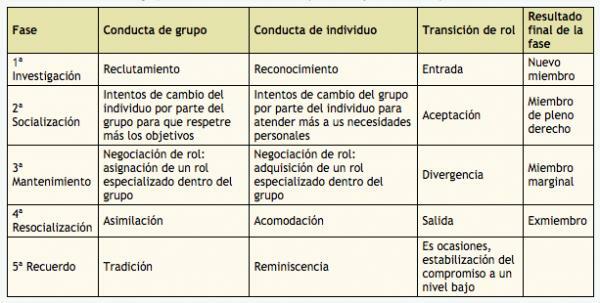
Studies on the perception of people were established as an independent area at the end of the 50s of the 20th century. Contribution of S. Asch: The focus of interest shifts from the study of the accuracy in the formation of impressions, to the study of the process through which these impressions are formed. Only an adequate perception of the environment that surrounds us, both physical and social, allows us to adapt to it. Perception comprises two processes: Recoding or selection of the enormous volume of data that comes to us from abroad and orn try to go beyond the information obtained, to predict future events and avoid or reduce surprise.
Index
- Historical development on perception of people
- Perception of people
- Definition and characteristics of people's perception
- Impression formation Definition
- Theories of the perception of people
Historical development on perception of people.
The "New Look" stream: Introduction of the motivations and experiences of the perceivers in the process of perception of the natural world. Bruner and Goodman experiment: Children between 10-11 years old, half with high purchasing power and the other half poorer, had to adjust a variable light circle to the size of various coins. Control groups fitted cardboard circles.
Results: The sizes of the most valuable coins were overestimated and those of the valuable hands were underestimated. The distortion was strongest in the poorest children. The fundamental thing in this approach is: Conceiving the perception as a selective process, much more dynamic and functional than previously assumed.
Jones summarizes the main lines and avenues of research, since the late 1950s, in the perception studies: The perceiver as reader of emotions. The perceiver as a good judge of the personality. The perceiver as integrator of the information. The recipient as a causal attributorship. The perceiver as a motivated actor.
Perception of people.
Processes and phenomena that constitute the study area of "social cognition":
- Our reaction to who approaches will depend on the emotion recognition that we carry out (diagnosis about your state of mind). This diagnosis is made from looking at your face and other non-verbal cues.
- Us we will form an impression about it, for which, we will unite the various informational elements that we have been collecting: physical appearance, clothing, way of speaking, attractiveness.
- We will make causal attributions, that is, we will look for some cause to explain the behavior of said person. Our thoughts, feelings and behaviors regarding such a person will be mediated by the type of cause that we attribute to their behavior.
An underlying activity to all these processes is the use of schemas (organized sets of knowledge we have about situations, people and ourselves).
Our reaction will be mediated by the processes of social inference: the way in which we process information, store it, relate it to other information, retrieve it and apply it to the case in question.
Definition and characteristics of the perception of people.
Studies of perception of people and perception of objects have been closely linked.
Similarities between the perception of objects and that of people:
- Both types of perceptions are structured: When we perceive them, we create an order. One form of organization is to create categories. In the world of objects, the categories are clear (animal world, colors). When we perceive a person, we have many categories to classify their behavior, appearance and other information: can be categorized according to their physical attractiveness, their personality, their origin, their career university. There are people who almost exclusively use a categorical system ("friend-foe", "attractive-unattractive"). However, most will be based on one or another category depending on the context ("attractive-unattractive" in dating situations).
- Both in the perception of objects and in the perception of people we tend to look for the invariant elements of the stimuli that we perceive (no interest in superficial or unstable aspects).
- Our perceptions of objects and others have meaning. Heider and Simmel: When people perceive moving points of light on a screen they often describe "one point chasing another", "the triangle runs away from the square."
Differences between perception of objects and people:
- People are perceived as causal agents and objects are not: Human beings have the intention of controlling the environment, therefore, the "deception" factor is important in the perception of people (irrelevant in the perception of objects).
- Other people are similar to us, which allows us to make a series of inferences that we cannot do in the case of objects. Inevitably, social perception involves the Self itself.
-
The perception of people usually occurs in interactions that have a dynamic character: when we perceive another person, we are simultaneously perceived.
Snyder, Tanke, and Berscheid asked a group of students to have a conversation telephone with an "attractive" girl (photograph), and to another group the same except that the girl was not attractive.
Results: The boys who thought they were talking to the "attractive" girl were more sociable, outgoing, and affectionate and, The girls who talked to the boys who found them attractive were also more sociable, affectionate, and extroverted. This can be explained as a reaction to the behavior of your interlocutors.
- The perception of people is more complex than the perception of physical stimuliBecause we usually have many crucial attributes that are not visible to the naked eye, and the accuracy in social perception is more difficult to verify.
Impression formation Definition.
The investigation of S. Asch:
How do we organize observed data into a single, unified impression?
Asch, is inclined towards a Gestalt conception: the various elements are organized as a whole (gestalt or configuration), so that each trait affects and is affected by all the others, generating an impression dynamic. Some traits have a greater impact on others. They are the central features. Traits presented to subjects as descriptors of a person are called stimulus traits. The traits on which the stimulus person must be classified are called response traits. Verification of the model by Asch:
A group of subjects received the description of a person who contained different traits (stimulus traits) and among which was the "affectionate" trait.
Another group received a description that contained the same traits and the "cold" trait. The only difference between the two trait lists was "affectionate" and "cold."
Results:
- The two groups responded differently both in the writing of portraits (more positive in the group that heard affectionate) and in the choice of adjectives.
- When Asch presented the same encouraging traits but using "polite-impolite" (instead of "affectionate-cool), the differences were weaker.
Conclusions:
- "Affectionate and cold" were central features in this context, as they served as a guide for organizing the information into a coherent whole: some characteristics were assigned to the affectionate person and the opposite to describe the person cold. Various characteristics, unaffected by affectionate / cold variation.
- A change in one of the qualities produce a substantial change in the overall impression.
This change should not be confused with the "halo effect": When a positive trait tends to have other positive traits associated with it, and a negative one to have other negative ones associated with it. The halo effect cannot explain Asch's results, because change does not occur in all qualities (in one positive direction in the case of affectionate and negative in the case of cold), but limited to some features.
What does it depend on whether a trait is central or peripheral ?:
The content and function of a quality depend on the context, that is, on the other stimulus traits.
- In another experiment in which "warm and cold" appeared alongside a different list of stimulus traits, they turned out to be entirely dependent or peripheral traits.
It is not that the same quality can be central or peripheral depending on the environment, but rather that, when a trait changes context and goes, for example, from being central to peripheral, there is a change in its meaning.
Asch's work began two important lines of research:
- It refers to the ways in which the information is processed (information integration).
- It refers to the relationship between stimulus traits and response traits. It led to Implicit Theories of Personality.
Theories of the perception of people.
Theories of the perception of people
- Relational trend models.
- Linear combination models.
- Fiske and Neuberg model
Relational trend models:
- They correspond to the Gestalt conception of Asch- All elements combine together to produce a single meaningful gestalt.
- Each characteristic has a meaning that is not independent of the meaning of the other characteristics.
- When the individual receives inconsistent information, he can do two things:
- Change the meaning of the characteristics ("happy" does not have the same meaning accompanied by "silly and calm" that of "affectionate and relaxed". This change occurs first in the descriptive dimension and then in the evaluative dimension ("happy" has a more positive value in the second case).
- Infer new features that reduce contradictions.
Linear combination models:
- Loas informative elements do not change their meaning but are combined with each other, adding, averaging or multiplying, so that the resulting impression is the result of the additive combination of some properties of the stimulus.
- The value of each trait is independent of the value of the others.
- There is a dimension along which any type of stimulus can be placed (evaluative dimension).
- Sum model: The final impression is the result of the sum of the values of each trait separately.
- Average model: The final impression would be the arithmetic mean of the values of each of the features separately (better model than the previous one).
- Weighted average model: Anderson formulated this model to overcome the explanatory limitations of the previous one.
The initial impression (Io) it's a kind of general bias that we use in our perceptions. It can be favorable, unfavorable or neutral.
Po (weight or importance of initial impression), depends on various factors, but one of the most important is the number or importance of the elements informational that make up the impression (the more you know a person, the less the importance of the impression initial).
One way to solve the appearance in a stimulus of contradictory information would be to dismiss the inconsistency, giving less weight to the contradictory features. It basically occurs in the evaluative dimension.
Various studies support both linear combination models and Asch's Gestalt conception.
Ostrom: "Both the average model and the change of meaning need internal clarification before explaining the process of impression formation."
There are results difficult to explain as the "negative effect of context": Occurs when a positive trait ("mother") is associated with a negative one ("cruel"), resulting in an extremely negative impression.
The average model, by admitting that the weight of each trait may vary from context to context (though not its value), allows for almost unlimited flexibility in impression formation.
Fiske and Neuberg model:
- Conjugate Asch's position with linear combination models.
- People form impressions in two ways: depending on the informative and motivational circumstances.
- Sometimes our schemes predominate or previous categories, as proposed by Asch's holistic model.
- In others, the informational data perceived, as in linear combination models.
- When we perceive a person:
- We do a quick and unconscious initial categorization. If the person is not of interest to us, the process ends here. If he is of interest to us, we will pay attention to the informational elements that he presents.
- Confirmation of categorization.
- Recategorization.
- Integration "piece by piece" of the different informative elements (it is only reached in case the previous possibilities fail).
This article is merely informative, in Psychology-Online we do not have the power to make a diagnosis or recommend a treatment. We invite you to go to a psychologist to treat your particular case.
If you want to read more articles similar to Definition and characteristics of perception of people, we recommend that you enter our category of Social and Organizational Psychology.


